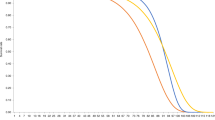Abstract
This research proposes the concept of “utility-adjusted life expectancy” (UALE), which adjusts the lifetime survival function with a more comprehensive utility measure that combines utilities from both consumption and health to investigate the influences of prevention intervention on a population’s well-being. We find that an economy with appropriate preventative healthcare provisions is associated with better human well-being and greater UALE in terms of utility-adjusted life years (UALYs). Based on Taiwan’s experiences, when the share of prevention spending to GDP increases from real 0.27% to 1.19% for growth maximization, the per capita GDP growth rate increases from 3.2% to 4%. Human well-being increases from 26.37 UALYs to 32.57 UALYs. Over all, human well-being increases by 6.2 UALYs. When this share is at 2.03% for welfare maximization, the economy grows at 3.9%, and the UALE increases by 6.65 UALYs. The economy trades a 0.1% economic growth rate reduction for 0.45 UALYs of well-being improvement.



Similar content being viewed by others
References
Bertram, M. Y., Lauer, J. A., De Joncheere, K. Edejer, T., Hutubessy, R., Kieny, M. P., & Hill, S. R. (2016). Cost-effectiveness thresholds: Pros and cons, Bulletin of the World Health Organization, 94925–930. http://www.who.int/bulletin/volumes/94/12/15-164418.pdf. Accessed June 10, 2019.
Cohen, J. T., Neumann, P. J., & Weinstein, M. C. (2008). Does preventive care save money? Health economics and the presidential candidate. New England Journal of Medicine, 358(7), 661–663.
Drummond, M. F., Sculpher, M. J., Torrance, G. W., O’Brien, B. J., & Stoddart, G. L. (2005). Methods for the economic evaluation of health care Programmes. Oxford: Oxford University Press.
Easterlin, R. A., Angelescu, L., & Zweig, J. S. (2011). The impact of modern economic growth on urban-rural differences in subjective well-being. World Development, 39(12), 2187–2198.
Garber, A. M. (2000). Advances in cost-effectiveness analysis of health interventions. In A. J. Culyer & J. P. Newhouse (Eds.), Handbook of health economics. Amsterdam: Elsevier.
Glasziou, P. P., Cole, B. F. R., Gelber, D., Hilden, J., & Simes, R. J. (1998). Quality-adjusted survival analysis with repeated quality-of-life measures. Statistics in Medicine, 17(11), 1215–1219.
Hall, R. E., & Jones, C. I. (2007). The value of life and the rise in health spending. Quarterly Journal of Economics, 122(1), 39–72.
Maciosek, M. V., Coffield, A. B., Flottemesch, T. J., Edwards, N. M., & Solberg, L. I. (2010). Greater use of preventive services in US health care could save lives at little or no cost. Health Affairs, 29(9), 1656–1660.
Murphy, K. M., & Topel, R. H. (2005). The value of health and longevity. Journal of Political Economy, 114(3), 871–901.
Murray, C. J. L., Salomon, J. A., Mathers, C. D., & Lopez, A. D. (2002). Summary measures of population health: Concepts, ethics, measurement and application. Geneva: WHO.
Patrick, D. L., & Erickson, P. (1993). Health status and health policy: Quality of life in health care evaluation and resource allocation. New York: Oxford University Press.
Rosen, S. (1994). The quantity and quality of life: A conceptual framework. In G. Tolley, D. Kenkel, & R. Fabian (Eds.), Valuing health for policy: An economic approach (pp. 221–248). Chicago: The University of Chicago Press.
Russell, L. B. (2007). Prevention’s potential for slowing the growth of medical spending. Washington: National Coalition on Health Care, October. Accessed July 24, 2018, at http://www.nchc.org/nchc_ report.pdf.) Idem.
Sacks, D. W., Stevenson, B., & Wolfers, J. (2012). The new stylized facts about income and subjective well-being. Emotion, 12(6), 1181–1187.
Stanfield, J. P. (1993). The balance between preventive and curative care. Tropical and Geographical Medicine, 45(5), 263–266.
Tolley, G., Kenkel, D., & Fabian, R. (1994). State-of-the-art health values. In G. Tolley, D. Kenkel, & R. Fabian (Eds.), Valuing health for policy: An economic approach (pp. 323–344). Chicago: University of Chicago Press.
Torrance, G. W. (1986). Measurement of health utilities for economic appraisal- a review. Journal of Health Economics, 5, 1), 1–1),30.
Verbrugge, L. M. (1984). Longer life but worsening health? Trends in health and mortality of middle-aged and older persons. The Milbank Memorial Fund Quarterly, 62(3), 475–519.
Verbrugge, L. M. (1989). Recent, present, and future health of American adjust. Annual Review of Public Health, 10(1), 333–361.
Wang, F., & Wang, J. D. (2017). Telehealth and sustainable improvements to quality of life. Applied Research in Quality of Life, 12(1), 173–184.
Wang, F., Wang, J. D., & Huang, Y. X. (2016). Health expenditures spent for prevention, economic performance, and social welfare. Health Economics Review, 6, 45.
WHO (World Health Organization). (2012). Measurement of healthy life expectancy and wellbeing. Geneva: Department of Health Statistics and Information Systems, WHO.
WHO (World Health Organization). (2014). WHO methods for life expectancy and healthy life expectancy. Geneva: Department of Health Statistics and Information Systems, WHO.
Acknowledgements
This work was supported by grants from the Ministry of Science and Technology of Taiwan (Grant no. MOST104-2410-H-006-109 -, MOST105-2410-H-006-091, MOST 107-2410-H-006-082-, and MOST 108-2410-H-006 -088 -MY2). The funder had no role in study design, data collection and analysis, decision to publish, or preparation of the manuscript.
Author information
Authors and Affiliations
Corresponding author
Ethics declarations
Conflict of Interest
The author has declared that no conflict of interest exist.
Additional information
Publisher’s Note
Springer Nature remains neutral with regard to jurisdictional claims in published maps and institutional affiliations.
Rights and permissions
About this article
Cite this article
Wang, F. The Influences of Prevention on the Quality of Life. Applied Research Quality Life 16, 129–139 (2021). https://doi.org/10.1007/s11482-019-09759-4
Received:
Accepted:
Published:
Issue Date:
DOI: https://doi.org/10.1007/s11482-019-09759-4




